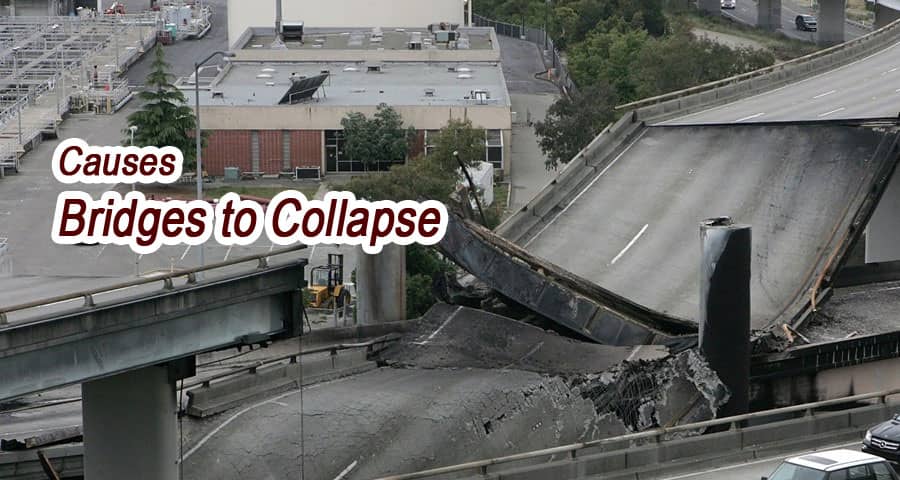What Causes Bridges to Collapse: Key Factors to Consider

Bridges are essential infrastructural elements that facilitate transportation and connect communities. They are designed to be strong, durable, and capable of withstanding various loads and stresses. However, under certain circumstances, bridges can collapse, leading to devastating consequences.
Introduction
Bridges are complex structures that must withstand a variety of forces, including the weight of the bridge itself, live loads such as vehicles and pedestrians, and environmental factors. When any of these factors exceed the bridge's capacity, it can lead to structural failure and, in the worst-case scenario, a collapse.
Insufficient Structural Design
One of the primary causes of bridge collapse is insufficient structural design. If a bridge is not designed to handle the anticipated loads and stresses it will experience during its lifespan, it becomes vulnerable to failure. Factors such as inadequate consideration of traffic volume, improper analysis of forces, or the use of outdated design standards can compromise a bridge's structural integrity.
Material Degradation
Over time, bridges can experience material degradation due to factors such as corrosion, fatigue, and aging. Corrosion, especially in steel and reinforced concrete bridges, can weaken the structural components and compromise their load-bearing capacity. Fatigue, caused by repetitive loading and unloading cycles, can lead to cracks and fractures in the bridge elements. Aging of materials, including concrete, can result in reduced strength and increased vulnerability to external forces.
Natural Disasters
Natural disasters pose a significant risk to bridge stability and can cause sudden collapses. Three common natural disasters that can affect bridges are flooding and water damage, earthquakes, and high winds.
- Flooding and Water Damage: Bridges located in flood-prone areas are susceptible to damage from rising water levels and swift currents. Excessive water flow can erode bridge foundations, scour the soil supporting bridge piers, and undermine the stability of the entire structure. Additionally, debris carried by floodwaters can impact bridge components, weaken structural elements, and lead to collapse.
- Earthquakes: Earthquakes generate powerful seismic forces that can severely affect bridge structures. The ground motion caused by an earthquake can induce dynamic loads that surpass a bridge's design capacity. The resulting vibrations and oscillations can cause structural damage, including the failure of support columns, piers, or foundations, ultimately leading to bridge collapse.
- High Winds: Strong winds can exert significant lateral forces on bridges, especially those with large surface areas, such as suspension or cable-stayed bridges. If a bridge is not designed to withstand these wind forces or if wind-induced vibrations are not properly addressed, it can lead to structural instability and collapse.
Poor Construction Practices
Inadequate construction practices can compromise a bridge's integrity right from its initial construction phase. Issues such as poor quality control, improper installation of structural elements, inadequate concrete curing, and insufficient welding can introduce weaknesses and defects that may lead to future failures. It is crucial to adhere to rigorous construction standards and procedures to ensure the structural soundness of bridges.
Lack of Maintenance and Inspections
Regular maintenance and inspections are vital to identifying and addressing potential issues before they escalate into significant problems. Lack of proper maintenance can allow minor defects to worsen over time, compromising the structural integrity of the bridge. Routine inspections, including visual inspections, non-destructive testing, and structural analysis, are essential for detecting signs of deterioration, corrosion, or structural weaknesses that could lead to a collapse if left unattended.
Human Error
Human error, whether in the design, construction, or maintenance phases, can contribute to bridge collapses. Mistakes in calculations, oversight of critical details, miscommunication, or neglecting safety protocols can all lead to catastrophic failures. Proper training, adherence to industry standards and codes, and a culture of safety awareness are crucial in mitigating human errors that could jeopardize bridge stability.
Conclusion
The collapse of bridges can have severe consequences, including loss of life, property damage, and disruption of transportation networks. Understanding the key factors that can cause bridge failures is essential for engineers, designers, and maintenance personnel involved in the construction and upkeep of bridges. By considering structural design, material degradation, natural disasters, construction practices, maintenance, inspections, and human error, we can work towards ensuring the safety and longevity of our bridges.
FAQs
Are bridge collapses common?
Bridge collapses are relatively rare but can have devastating consequences when they occur. Strict design standards, construction practices, and maintenance protocols aim to minimize the risk of collapse.
How often should bridges be inspected?
The frequency of bridge inspections varies depending on factors such as the bridge's age, location, and condition. Generally, routine inspections are conducted every one to two years, with more detailed inspections occurring every few years or as necessary.
Can bridges be retrofitted to withstand earthquakes?
Yes, bridges can be retrofitted to improve their seismic resistance. Retrofitting measures may include strengthening structural elements, adding damping devices to absorb seismic energy, and implementing better foundation design.
What is the lifespan of a typical bridge?
The lifespan of a bridge depends on various factors, including its design, materials used, maintenance practices, and environmental conditions. With proper care and maintenance, bridges can last for several decades.
Who is responsible for bridge maintenance?
Bridge maintenance is typically the responsibility of the government agency or authority overseeing the bridge, such as a state or local transportation department.
